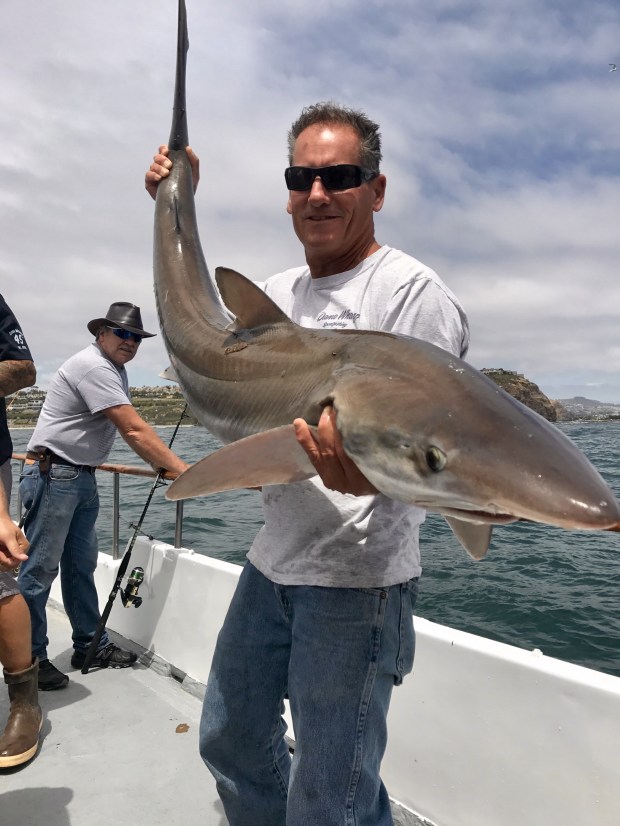SoCal Captain’s Boat Hooks (And Releases) Coveted Soupfin Shark

As a traveler, I can’t get enough of all of those personalities lucky enough to – on someone else’s dime – visit exotic locales throughout the globe and spew their thoughts on why you should join them in Paris, in Singapore, in South Africa, wherever (you’ll just have to pay your own way, chumps!).
I also remember how many times these hosts dine on controversial gourmet dishes like foie gras, a fancy Franco-fied way to describe the less palatable goose liver pate. Critics will tell you eating such a delicacy promotes cruelty, considering that farmers who raise the birds reportedly will overfeed and stuff the geese or ducks to the point of making even those of those who see PETA as mostly a joke uncomfortable.
Here’s the Telegraph with more:
Foie gras is a luxury substance made from the liver of duck or geese. It is traditionally associated with France, though evidence suggests it has been eaten for thousands of years in various countries: one Roman emperor supposedly fed his dogs with it.
The controversy arises from the way the ducks or geese are specially fattened to produce the delicacy. The birds are traditionally force-fed corn with a feeding tube, a process known as gavage. All this extra energy gets stored as fat in the birds’ livers, which grow until they are about 10 times their normal size, at which point the animals are slaughtered. The overfeeding causes a chemical change within the liver as it stores fat cells, creating a rich and buttery texture.
Animal rights campaigners claim this is cruel, citing studies that show the birds find it difficult to walk, try to avoid feeding, and suffer damage to their esophaguses.
California lawmakers had gone so far as banning restaurants from keeping the dish on its menu (I’m sure that wasn’t fibbed a few times for diners agreeing to go off the board to get a plate to its table). The ban was lifted in 2015, but it’s clear that it’s a bit of a polarizing subject.
In that vein, another species that created a lot of controversy in the culinary arts is the threatened soupfin shark, which is rarely seen in waters around California and is infamously linked to shark fin soup, which like foie gras is no less contentious between those who eat it and those who oppose it.
From LA Weekly:
Shark fin soup has long been savored in some Chinese-American communities as a high-priced, special-occasion dish. Experts say a vast majority of fins found in the United States come through the ports of Los Angeles and Long Beach. In 2013 the state banned the possession and sale of shark fins, and last year a challenge to the law was rejected by the U.S. Supreme Court.
The Shark Fin Sales Elimination Act by U.S. Rep. Ed Royce of Fullerton would extend a similar prohibition to all 50 states. In the upper house, Sen. Cory Booker’s Shark Fin Trade Elimination Act would prohibit the import, export, sale and trade of shark fins. The fishing industry is fighting the legislation, while animal rights advocates say the practice of finning, in which sharks are often maimed and left for dead, needs to stop.
Shark finning is illegal in domestic waters, but sharks are sometimes caught outside the United States and their fins imported. Advocates for the business argue that federal regulations already require all domestic fishing to be ecologically sustainable and that so few sharks fins traded in the United States — the Sustainable Shark Alliance says the country is responsible for about 3 percent of global shark fin trade — that the law is unnecessary.
I promise I’m getting to the point, so here we go, as the above photo depicts, a Southern California angler incidentially hooked a 7-foot soupfin shark. The Orange County Register has more:
Just minutes after a fisherman hooked a 100-pound rare soupfin shark, Capt. Chris Pica helped calm and free the seven-footer.
It was during a charter fishing trip Saturday, June 10, off local South Orange County waters when Pica and a group of fishermen out on a birthday fishing trip came across the dark gray shark.
The fishermen were targeting white sea bass when all of a sudden one of them hooked something different.
The shark had a long slender body, a long snout, a small second dorsal fin and a large lobe on the upper section of its tail.
“He put up a good fight and we chased him all around the boat,” said Pica, who three weeks ago made national news after rescuing an entangled great white shark in the surf line off Capistrano Beach. …
But for Pica, who has become a shark whisperer-of-sorts, giving this shark a second chance was important.
“I’ve been fishing these waters since 1989 and I’ve never seen a soupfin shark,” he said. “They are very rare. At one time they were fished out.”
According to the Monterrey Bay Aquarium, Soupfin was the biggest shark fishery in California in the 1930s and 1940s.
Soupfin sharks were coveted for making a popular sharkfin soup. Their livers also held value, containing high levels of vitamin A.
Well done, Capt. Pica!



